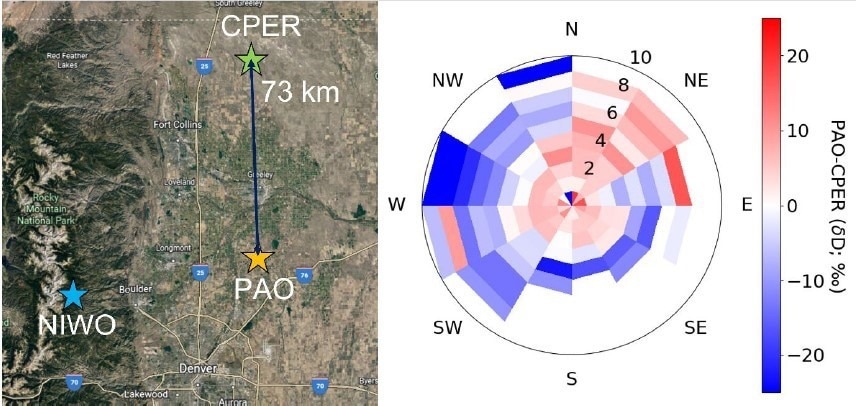Researchers demonstrated that a new mid-infrared spectrometer can accurately quantify the ratios of different kinds of water — referred to as isotopologues — in atmospheric water vapor in less than 15 minutes via open air. Isotopologue ratios, which can be influenced by land-based water evaporation and plant transpiration, are used to create climate change models and to better comprehend how water moves around the world in the atmosphere.
 Left: Satellite image of northern Colorado Front Range with stars indicating locations of NEON CPER, NEON NIWO and PAO measurement sites. Image: Google Earth. Right: Difference between PAO and CPER δD binned as a function of PAO wind speed (in m/s) and direction. Generally, δD at PAO is greater than CPER for winds from the northeast and lower than CPER for high westerly winds. Image Credit: Optica
Left: Satellite image of northern Colorado Front Range with stars indicating locations of NEON CPER, NEON NIWO and PAO measurement sites. Image: Google Earth. Right: Difference between PAO and CPER δD binned as a function of PAO wind speed (in m/s) and direction. Generally, δD at PAO is greater than CPER for winds from the northeast and lower than CPER for high westerly winds. Image Credit: Optica
Open-path sensing using dual-frequency combs may make atmospheric water vapor isotopologue sensing simpler and easier to apply in remote environments. A broader network of isotopologue measurements will contribute to improving numerical weather modeling. The long beam paths achievable using the dual-comb technique will enable spatially resolved studies of water vapor transport over natural ecosystems as well as human-engineered ones (e.g. farms).
Daniel Herman, Researcher, National Institute of Standards and Technology
“Future vertical column measurements using combs might also improve calibration procedures for isotopologue measurement using satellites. In addition, sensing of water vapor with dual combs can also compliment other emerging air quality applications of broadband mid-infrared spectroscopy.”
NIST’s Daniel Herman will implement the new research results at the Optica Imaging and Applied Optics Congress, which will take place from July 11th to 15th, 2022. Herman’s presentation is planned for July 11th, 2022, at 11:45 am. PDT.
To analyze isotopologues in atmospheric water vapor, researchers now depend on connections of point sensors. Although these networks are growing in size, careful calibration is required to maintain precision over time and between sites.
Identifying water vapor in an open-air path may remove the need for quantification and make large-scale evaporation above reservoirs or across complete watersheds simpler to acquire.
To identify different water vapor isotopologues in the air, a mid-infrared spectrometer with a high spectral resolution, good precision, and quick measurement rates is required. Herman and colleagues achieved this by developing a new open-path mid-infrared dual-comb spectrometer (DCS) that utilizes near-infrared femtosecond laser pulses and specially built waveguides to generate broadband mid-infrared pulses in a small form.
The scientists put the new instrument to the test by taking measurements over a 760-meter path at Colorado’s Platteville Atmospheric Observatory. They discovered that the instrument is able to function in the field for weeks without human intervention. This permitted them to collect data for several months in a wide range of weather and temperature conditions.
The DCS measurements are well correlated with those obtained using a point sensor network, indicating the potential for open-path DCS in characterizing atmospheric water vapor.
Herman adds, “To expand isotopologue measurement networks, we are working to improve the accuracy of our technique by analyzing systematics in the detection setup. The sensitivity of the technique can be improved by using higher power combs to enable longer paths. Also, balanced detection technology will be implemented in the future to decrease technical noise.”